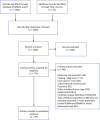Extramedullary disease in multiple myeloma: a systematic literature review
- PMID: 35314675
- PMCID: PMC8938478
- DOI: 10.1038/s41408-022-00643-3
Extramedullary disease in multiple myeloma: a systematic literature review
Abstract
Extramedullary involvement (or extramedullary disease, EMD) represents an aggressive form of multiple myeloma (MM), characterized by the ability of a clone and/or subclone to thrive and grow independent of the bone marrow microenvironment. Several different definitions of EMD have been used in the published literature. We advocate that true EMD is restricted to soft-tissue plasmacytomas that arise due to hematogenous spread and have no contact with bony structures. Typical sites of EMD vary according to the phase of MM. At diagnosis, EMD is typically found in skin and soft tissues; at relapse, typical sites involved include liver, kidneys, lymph nodes, central nervous system (CNS), breast, pleura, and pericardium. The reported incidence of EMD varies considerably, and differences in diagnostic approach between studies are likely to contribute to this variability. In patients with newly diagnosed MM, the reported incidence ranges from 0.5% to 4.8%, while in relapsed/refractory MM the reported incidence is 3.4 to 14%. Available data demonstrate that the prognosis is poor, and considerably worse than for MM without soft-tissue plasmacytomas. Among patients with plasmacytomas, those with EMD have poorer outcomes than those with paraskeletal involvement. CNS involvement is rare, but prognosis is even more dismal than for EMD in other locations, particularly if there is leptomeningeal involvement. Available data on treatment outcomes for EMD are derived almost entirely from retrospective studies. Some agents and combinations have shown a degree of efficacy but, as would be expected, this is less than in MM patients with no extramedullary involvement. The paucity of prospective studies makes it difficult to justify strong recommendations for any treatment approach. Prospective data from patients with clearly defined EMD are important for the optimal evaluation of treatment outcomes.
© 2022. The Author(s).
Conflict of interest statement
J.B. has received speaker/lecture honoraria from Janssen, Celgene/BMS, Amgen, Takeda, and Oncopeptides. M.B. has received speaker honoraria from Amgen, Oncopeptides, Janssen, Sanofi, and Takeda. Jo Caers has received research funding from Takeda and Janssen; and honoraria from Janssen, Amgen, BMS-Celgene, and Sanofi. A.J. has received honoraria from Janssen, BMS, Takeda, Sanofi, GSK, Karyopharm, Oncopeptides, and Amgen. M.v.L.-T. has received research funding from Celgene and Oncopeptides; and honoraria from BMS/Celgene, Oncopeptides, Janssen, GSK, and Takeda. Philippe Moreau has received honoraria from Janssen, Celgene, Amgen, AbbVie, Oncopeptides, and Sanofi. Leo Rasche has received honoraria from BMS/Celgene, Sanofi, GSK, Oncopeptides, and Janssen. Laura Rosiñol has received speaker honoraria from Janssen, Celgene, Amgen, Takeda, GSK, and Sanofi. S.Z.U. has received research funding and/or honoraria from Amgen, Celgene, Janssen, Takeda, BMS, Oncopeptides, and Sanofi. E.Z. has received honoraria from, and been an advisory board member for, Janssen, BMS, Takeda, Sanofi, GSK, Karyopharm, Oncopeptides, and Amgen. P.R. has received institutional research support from Oncopeptides, Celgene/BMS, Takeda, and Karyopharm. He has received honoraria for his role as an Advisory Committee member from Karyopharm, Oncopeptides, Celgene/BMS, Takeda, Janssen, Sanofi, Secura Bio, GSK, Regeneron, AstraZeneca, and Protocol Intelligence.
Figures
References
-
- Rajkumar SV, Dimopoulos MA, Palumbo A, Blade J, Merlini G, Mateos MV, et al. International Myeloma Working Group updated criteria for the diagnosis of multiple myeloma. Lancet Oncol. 2014;15:e538–e548. - PubMed
-
- Bladé J, Fernández de Larrea C, Rosiñol L, Cibeira MT, Jiménez R, Powles R. Soft-tissue plasmacytomas in multiple myeloma: incidence, mechanisms of extramedullary spread, and treatment approach. J Clin Oncol. 2011;29:3805–12. - PubMed
-
- Rosiñol L, Beksac M, Zamagni E, Van de Donk NWCJ, Anderson KC, Badros A, et al. Expert review of soft-tissue plasmacytomas in multiple myeloma: definition, disease assessment and treatment considerations. Br. J. Haematol. 2021; 10.1111/bjh.17338. - PubMed
-
- Rosiñol L, Fernández de Larrea C, Bladé J. Extramedullary myeloma spread triggered by surgical procedures: an emerging entity? Acta Haematol. 2014;132:36–8. - PubMed


